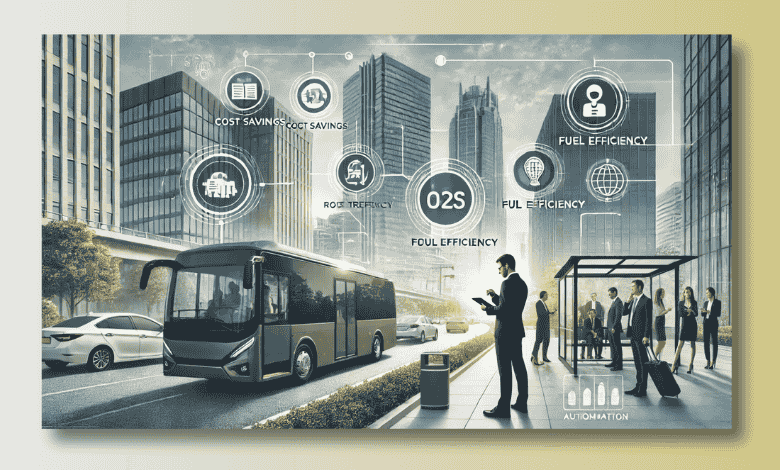Cutting Costs While Ensuring Comfort: How Employee Transport Automation Saves Organizations Millions

Introduction
Employee transport is a critical yet often overlooked aspect of corporate operations, with global companies spending billions annually on workforce commuting. According to industry reports, inefficient transport management can inflate costs by up to 20% due to poor route planning, excessive fuel consumption, and manual coordination inefficiencies. For organizations relying on large-scale employee transportation, automating employee transport management is no longer optional—it is a necessity for cost efficiency, employee safety, and operational scalability. This case study highlights how implementing an advanced Employee Transport Management Software (ETMS) can reduce costs, enhance service reliability, and boost employee satisfaction.
The True Cost of Manual Transport Management
Traditional transport management involves numerous hidden costs:
- Direct vehicle expenses
- Communication overhead
- Administrative manpower
- Paper-based documentation
- Billing inefficiencies
- Lost productivity
Breaking Down the ROI of Adopting Employee Transport Management Software

A Case Study: Tech Corp India
1. Direct Cost Savings (10-12%)
- Fleet size: 100 vehicles
- Previous monthly cost: ₹60,00,000
- Post-automation savings: ₹7,80,000/month
- Key factor: Optimal route planning reduced vehicle requirement by 12%
2. Communication Cost Reduction (2-4%)
Real-world Impact:
- Previous spending: ₹30/employee/month on calls
- Current spending: ₹6/employee/month
- Monthly saving: ₹24/employee
- Key factor: Digital communications eliminated the need for manual coordination
3. Manpower Efficiency
Before Automation:
- 4 employees managing 1000 employee transport
- Cost: ₹1,40,000/month
After Automation:
- 3 employees managing 1000+ employees
- Saving: ₹100,000/month
- Key factor: Enhanced productivity and reduced overtime
4. Documentation and Printing (0.5-1%)
Digital Transformation:
- Previous cost: ₹30/employee/month
- Current cost: Negligible
- Annual saving for 1000 employees: ₹3,60,000
- Environmental impact: 12,000 sheets saved monthly
5. Billing Accuracy (0.5-1%)
Financial Impact:
- Previous reconciliation errors: 2-3%
- Current error rate: <0.1%
- Monthly saving: ₹30/employee
- Key factor: Automated vendor payments and reconciliation
Indirect Benefits with Measurable Impact
1. Employee Productivity
- Time saved: 10 minutes/day/employee
- Monthly value: ₹500/employee
- Annual impact for 1000 employees: ₹60,00,000
- Key factor: Improved work-life balance
2. Safety Improvements
- 98% reduction in safety incidents
- Lower insurance premiums
- Enhanced company reputation
- Key factor: Priceless peace of mind for employees and families
Comparative Analysis: Manual vs. Automated
Manual System Costs (per 1000 employees)
- Basic transport cost: ₹60,00,000
- Administrative overhead: ₹1,40,000
- Communication: ₹30,000
- Documentation: ₹30,000
- Total: ₹62,00,000
Automated System Costs (per 1000 employees)
- Optimized transport cost: ₹52,20,000
- Reduced overhead: ₹40,000
- Digital communication: ₹6,000
- Digital documentation: ₹3,000
- Total: ₹52,69,000
Monthly Savings Breakdown (per employee)
- Direct Vehicle Cost: ₹780
- Communication: ₹24
- Administrative: ₹100
- Documentation: ₹30
- Billing Accuracy: ₹30
- Productivity Gains: ₹500
Total Monthly Saving: ₹964
Conclusion
Investing in an Employee Transport Management Software (ETMS) is not just a cost-cutting measure—it is a strategic decision that impacts efficiency, compliance, and employee experience. Organizations that automate their transport management see a 16% overall cost reduction, achieve ROI within 3-4 months, and experience notable improvements in safety and operational transparency. As workforce mobility continues to grow, businesses that leverage smart transport automation will gain a competitive edge by reducing expenses, boosting productivity, and ensuring seamless employee commutes.
Key Takeaways
- 16% overall cost reduction
- ROI achievement within 3-4 months
- Substantial indirect benefits
- Improved employee satisfaction
- Enhanced safety and compliance
Know more about our AI-powered employee transport management software, or contact us to discover how your organization can achieve similar results through employee transport automation.
FAQ’S
How can employee transport automation reduce operational costs?
Employee transport automation optimizes routes, reduces fuel consumption, minimizes vehicle wear, and streamlines scheduling and staffing. By using real-time data and analytics, organizations can cut unnecessary expenses, such as overtime costs and inefficient routes, ultimately saving money.
Will automated employee transport systems improve employee satisfaction?
Yes! Automated systems ensure punctuality, comfort, and reliability. Employees will experience smoother and more predictable transport services, reducing stress and improving overall satisfaction. Automation can also help in creating less crowded, more comfortable vehicles, enhancing the overall commute.
How long does it take to see a return on investment (ROI) after implementing employee transport automation?
Typically, companies begin to see ROI within 6 to 12 months, depending on the size of the fleet and the level of automation. The savings in fuel, labor, and operational costs often outweigh the initial setup costs in the first year.
What are the key features of an automated employee transport system?
Key features include real-time GPS tracking, route optimization, scheduling automation, digital reporting and analytics, and integration with employee management systems. These features ensure efficient operations and enhanced service quality.
Is employee transport automation suitable for all types of organizations?
Yes, automation can be adapted to any organization, regardless of size. Whether it’s a large corporation with a fleet of buses or a smaller company with a few vehicles, automated transport systems can scale to meet specific needs, providing cost-effective solutions and improving the overall employee commute experience.